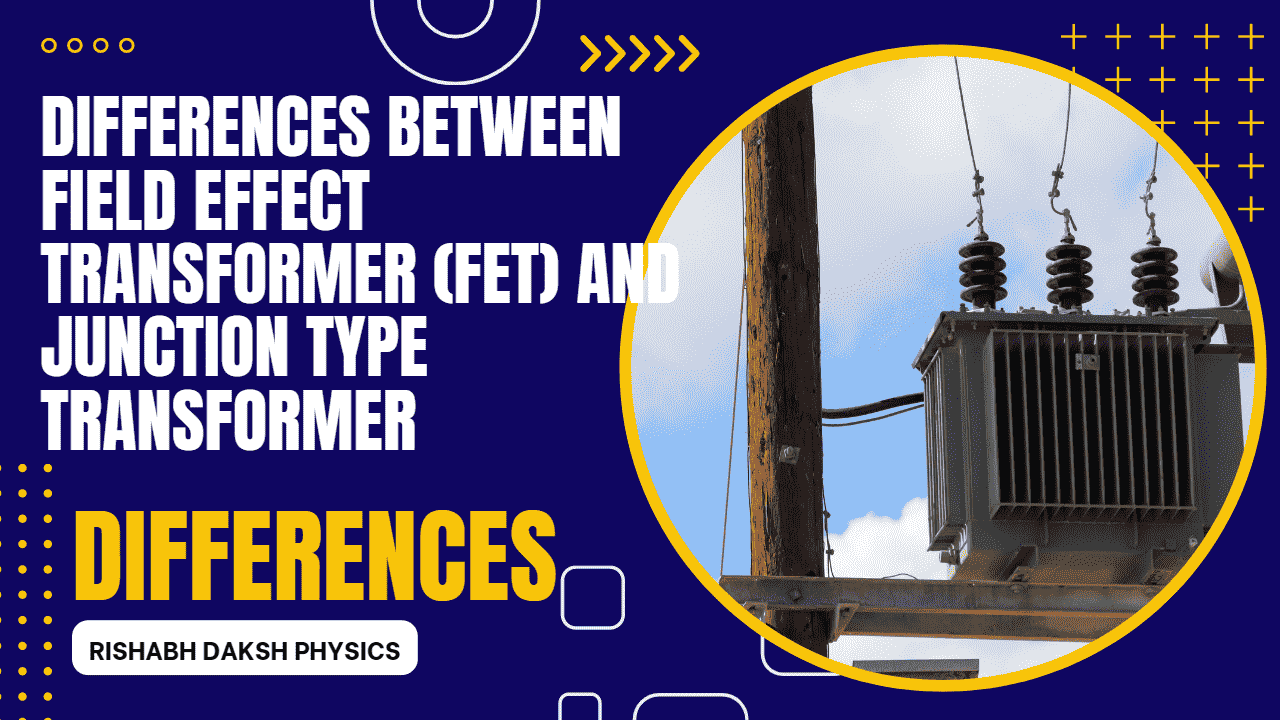Differences Between Field Effect Transformer (FET) and Junction Type Transformer
| POINTS | FIELD EFFECT TRANSFORMER(FET) | JUNCTION TYPE TRANSFORMER |
|---|---|---|
| Construction | FETs employ a solid-state design utilizing a combination of semiconductor materials. | Junction Type Transformers have insulated copper coils wound around a ferromagnetic core. |
| Operation | FETs operate based on electrostatic induction and utilize an electric field for power transfer. | Junction Type Transformers rely on electromagnetic induction for power transfer. |
| Efficiency | FETs exhibit high efficiency due to reduced power losses and improved thermal management. | Junction Type Transformers have good efficiency, but can be less efficient than FETs. |
| Application | FETs are commonly used in power distribution, renewable energy systems, electric vehicles, and aerospace. | Junction Type Transformers are employed in power transmission, distribution systems, and industrial setups. |
Introduction
In the realm of transformers, two prominent technologies stand out: Field Effect Transformers (FETs) and Junction Type Transformers. While both serve the purpose of electrical power transmission, they differ in several key aspects. In this article, we will delve into the intricacies of FETs and Junction Type Transformers, exploring their unique features, functionalities, and applications.
1. Construction
Field Effect Transformer (FET)
FETs employ a solid-state design, utilizing a combination of semiconductor materials to achieve efficient power transformation. These transformers consist of multiple layers of silicon and other semiconductor materials, carefully engineered to facilitate the transfer of electrical energy. The construction of FETs ensures compactness, high power density, and enhanced thermal management.
Junction Type Transformer
On the other hand, Junction Type Transformers adopt a more traditional construction approach. They comprise a series of insulated copper coils wound around a core made of ferromagnetic material. This core facilitates the electromagnetic induction process, converting electrical energy from one coil to another.
2. Operational Principles
Field Effect Transformer (FET)
FETs operate based on the principle of electrostatic induction. They utilize an electric field generated by the semiconductor layers to induce voltage and current in the primary and secondary windings, respectively. By carefully controlling the electric field, FETs achieve efficient power transfer with minimal losses.
Junction Type Transformer
Junction Type Transformers rely on the phenomenon of electromagnetic induction to transfer electrical power. As alternating current flows through the primary winding, it generates a magnetic field in the ferromagnetic core. This magnetic field induces a voltage in the secondary winding, enabling power transfer.
3. Efficiency
Field Effect Transformer (FET)
Due to their solid-state design and careful engineering, FETs boast high efficiency levels. The use of semiconductor materials allows for reduced power losses and improved thermal management. FETs also exhibit minimal leakage inductance, ensuring efficient power transmission across different load conditions.
Junction Type Transformer
Junction Type Transformers exhibit good efficiency, but they are often surpassed by FETs in terms of overall performance. The presence of magnetic cores and winding resistance introduces certain losses, reducing the overall efficiency. However, advancements in core materials and winding techniques have improved the efficiency of Junction Type Transformers in recent years.
4. Applications
Field Effect Transformer (FET)
FETs find extensive applications in various industries, including power distribution, renewable energy systems, electric vehicles, and aerospace. Their compact size, high power density, and excellent thermal management make them ideal for space-constrained environments. FETs are also known for their ability to handle high-frequency power conversion with minimal losses.
Junction Type Transformer
Junction Type Transformers have a long-standing history of applications in power transmission and distribution systems. They are commonly employed in substations, electrical grids, and industrial setups. Junction Type Transformers excel in scenarios where high power levels and voltage transformations are required.
Conclusion
In conclusion, both Field Effect Transformers (FETs) and Junction Type Transformers have their distinct characteristics and applications. FETs offer advantages such as compactness, high power density, and efficient thermal management, making them suitable for diverse industries. On the other hand, Junction Type Transformers have a proven track record in power transmission and distribution applications, although they may have slightly lower overall efficiency. Understanding the differences between these transformer types enables informed decision-making when selecting the most appropriate solution for specific electrical power requirements.






.png)

No comments:
Post a Comment
Have Any Query ? Ask Here or Comment...